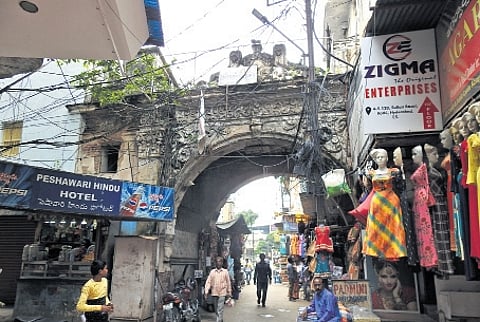

HYDERABAD: Koti Women’s College, the erstwhile British Residency, was originally a sprawling complex, with many historic structures built around the main building. The foundation was laid in 1803 and Samuel Russels of Madras Engineers designed the complex with two main entrances, the Empress Gate which provided entry from the southern side, the bank of Musi river and the second from the North, leading to the present entrance with a large portico, massive corinthian columns and a grand staircase.
Through a research conducted by conservation architect Vasant Sobha, many other historic structures have been discovered within the complex. In a booklet titled ‘Retracing Connections’, released with INTACH, the architect mentions the Residency’s connection with the present-day Sultan Bazar— a busy market and a haven for shopping lovers. The Sultan Bazar-Badi Chowdi lane, also known as the Hashmat Gunj lane, were part of the areas known as Residency Bazars during colonial times and developed around the construction of the Residency.
However, Hashmat Gunj gate is a stand alone structure which was probably built even before that time. Hashmat Jung was the title given to James Achilles Kirkpatrick (whose vision led to the construction of the Residency) by the Nizam of Hyderabad. The northern suburbs of the Residency were hence called Hashmat Gunj.
“The Hashmat Gunj gate, connecting the Kabootar Khana courtyard and the Hashmat Gunj lane in Sultan Bazar, boasts of a style, form, material and technique similar to that used in early colonial architecture and construction. The gate carries the British insignia of the two lions and coat of arms, possibly of the East India Company, suggesting its date of construction prior to 1835,” mentions the booklet.
Architect Vasant Sobha mentions coming across this gate during her childhood, while shopping with her friends. “As a Hyderabadi, I know Sultan Bazar to be a shopping paradise for many girls. I remember seeing this gate when we went shopping in our childhood and my sister, who studied in the Women’s college, identified it too. But at that time, we didn’t know much about its historical significance,” she said.
Talking about how she delved into the history of the structure, she said, “M Arch thesis was focused on colonial heritage of Hyderabad, proposing conservation strategies. It included a detailed study of the British Residency and Secunderabad’s historic buildings. At the beginning of the Bade Chowdi lane (in Bata junction) there was an MCH stone board with the name Hashmat Gunj lane, which provided a clue to the rich history of the place. I have a photo of the Hashmat Gunj Gate taken in 1996,” she said.
In 2006, her letter to the Andhra Pradesh High Court was accepted as a suo-moto PIL for a National Monument Status to be given to the Hyderabad Residency at par with the Lucknow Residency. In 2007, the British Residency of Hyderabad got the recognition of a State Protected Monument through the PIL.
“The Heritage Department took the site of the Residency under its purview including the structures within the campus of the Koti Women’s College but left out other historic structures belonging to the Residency out of its scope for restoration,” she said.
“I have written many letters to the MAUD, Heritage Department and the GHMC, bringing to their notice, the neglect of the structures outside the women’s college, especially the Hashmat Gunj gate. We conducted heritage walks with INTACH convenor Anuradha Reddy and prepared a small booklet on the gate’s history and significance in 2019. Conservation Architect Bindu Bhargavi Chandana studied the topic for her M Arch thesis in 2021 and prepared a comprehensive report of the Residency area and Chaderghat,” she told CE.
In 2022, she wrote another letter to the High Court of Telangana, appealing to direct the officials to restore the Residency structures outside the Women’s college, especially the gate. “It has a high potential for conservation and development as a local recreational spot, providing opportunity to reconnecting this beautiful gate to the grand British Residency and creating awareness among locals and children,” she concluded.